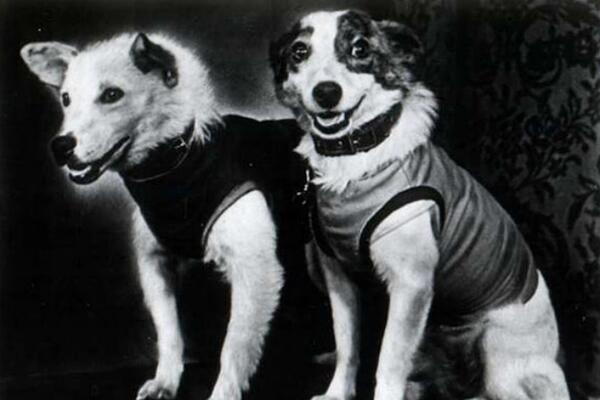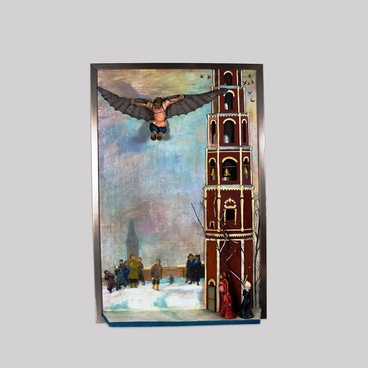In 1957, the chief rocket designer Sergei Pavlovich Korolev set a task to prepare dogs for a 24-hour orbital flight with the possibility of returning back in a descent vehicle. 12 animals were selected as candidates.
The initial selection was carried out according to a special method: the dogs had to weigh up to 6 kilograms, be up to 35 centimeters tall, and be two to six years old. Scientists could only count on female dogs because it was easier to develop a bodily waste disposal device for them.
There were also requirements for the exterior of the candidates: their fur had to be light — for better visibility on monitor screens. Besides, the first space dogs had to look attractive — in case they would be filmed and shown by the media.
For several months, the dogs were accustomed to a long stay in cramped small cabins in the conditions of prolonged isolation and noise. To this effect, they were put in a metal box, its size corresponding to that of the container of a descent vehicle, and then left for a long time placed in a mockup model of the spacecraft. This turned out to be the most difficult for the animals. It was easier and faster for the dogs to get used to taking special food from feeding machines, wearing clothes and sensors, and using the toilet in space conditions.
Belka (“Squirrel”) and Strelka (“Arrow”) were among the selected animals. The former — a light mongrel — was the most active and quickly learned to bark if something went wrong. The latter — a similar mongrel dog — turned out to be the friendliest. They were to become the passengers of the next Sputnik.
On August 19, 1960, the second spacecraft with dogs on board was successfully launched from Launch Complex No. 1. Together with them, mice, insects, plants, fungal cultures, seeds, some types of microbes, and other biological objects went into space. The purpose of the experiment was to investigate the effect of space flight on different creatures, as well as to work out life support systems and arrange the return to Earth.
The space journey of Belka and Strelka lasted for more than 25 hours. Over this time, the spaceship made 17 complete orbits around the Earth.
After their historic flight, the dogs lived at the Institute of Aviation and Space Medicine, from where they were taken to shows in kindergartens and schools. A few months later, Strelka brought offspring — six absolutely healthy puppies. One of them was presented to Jacqueline Kennedy, the wife of the US president.
The initial selection was carried out according to a special method: the dogs had to weigh up to 6 kilograms, be up to 35 centimeters tall, and be two to six years old. Scientists could only count on female dogs because it was easier to develop a bodily waste disposal device for them.
There were also requirements for the exterior of the candidates: their fur had to be light — for better visibility on monitor screens. Besides, the first space dogs had to look attractive — in case they would be filmed and shown by the media.
For several months, the dogs were accustomed to a long stay in cramped small cabins in the conditions of prolonged isolation and noise. To this effect, they were put in a metal box, its size corresponding to that of the container of a descent vehicle, and then left for a long time placed in a mockup model of the spacecraft. This turned out to be the most difficult for the animals. It was easier and faster for the dogs to get used to taking special food from feeding machines, wearing clothes and sensors, and using the toilet in space conditions.
Belka (“Squirrel”) and Strelka (“Arrow”) were among the selected animals. The former — a light mongrel — was the most active and quickly learned to bark if something went wrong. The latter — a similar mongrel dog — turned out to be the friendliest. They were to become the passengers of the next Sputnik.
On August 19, 1960, the second spacecraft with dogs on board was successfully launched from Launch Complex No. 1. Together with them, mice, insects, plants, fungal cultures, seeds, some types of microbes, and other biological objects went into space. The purpose of the experiment was to investigate the effect of space flight on different creatures, as well as to work out life support systems and arrange the return to Earth.
The space journey of Belka and Strelka lasted for more than 25 hours. Over this time, the spaceship made 17 complete orbits around the Earth.
After their historic flight, the dogs lived at the Institute of Aviation and Space Medicine, from where they were taken to shows in kindergartens and schools. A few months later, Strelka brought offspring — six absolutely healthy puppies. One of them was presented to Jacqueline Kennedy, the wife of the US president.



